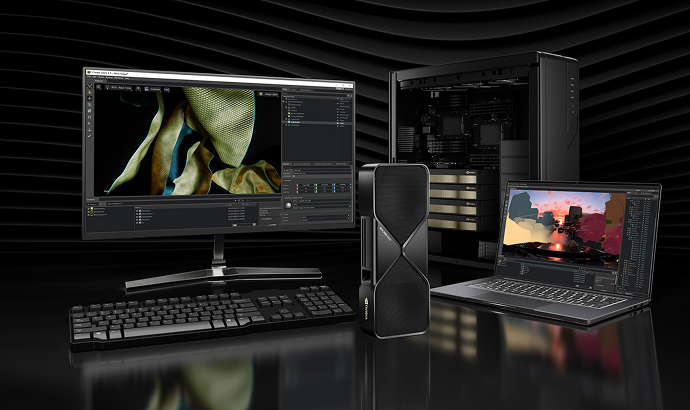

Writing About AI
Uvation
Reen Singh is an engineer and a technologist with a diverse background spanning software, hardware, aerospace, defense, and cybersecurity. As CTO at Uvation, he leverages his extensive experience to lead the company’s technological innovation and development.

The NVIDIA DGX™ B200 system is described as the universal platform purposefully built for all demanding AI infrastructure and workloads, positioning itself as the “foundation for your AI factory”. It is an integrated, rack-mount supercomputer delivered in a 10U form factor. The emergence of generative AI (GenAI) and large language models (LLMs) has fundamentally reshaped computational demands, and the DGX B200 is designed to meet these needs by delivering unprecedented speed, efficiency, and scale. By leveraging the cutting-edge Blackwell architecture, the DGX B200 serves as the modular building block for creating highly scalable AI clusters, notably through the NVIDIA DGX SuperPOD™ reference architecture.
The Blackwell architecture is the successor to the 2022-era Hopper generation. It integrates several cutting-edge technologies explicitly designed for massive-scale AI. A key innovation is the dual-die architecture for each B200 GPU, fusing two GPU chips into a single package using a high-bandwidth interconnect supporting speeds of 10 TB/s. A single Blackwell GPU boasts 208 billion transistors, which is a substantial increase compared to the 80 billion transistors found in the preceding H100 and H200 GPUs. Additionally, the architecture features the fifth-generation NVIDIA NVLink®, providing 1.8 TB/s of GPU-to-GPU bandwidth, which is crucial for allowing thousands of GPUs to operate as one single giant GPU. For advanced precision, Blackwell incorporates the second-generation Transformer Engine and introduces the NVFP4 low-precision format to enhance efficiency without compromising accuracy, driving a generational leap in inference performance.
The DGX B200 is equipped with eight NVIDIA Blackwell GPUs. It features a substantial total GPU memory of 1,440 GB (approximately 180 GB HBM3e per GPU). The system delivers a training performance of 72 petaFLOPS (using FP8 precision) and an inference performance of 144 petaFLOPS (using FP4 precision). The system’s interconnect utilizes the 5th Gen NVLink to achieve 14.4 TB/s aggregate all-to-all GPU bandwidth. Other key components include two Intel® Xeon® Platinum 8570 Processors (112 cores total), 2 TB of system memory configurable up to 4 TB DDR5 RAM, and high-speed networking supporting up to 400Gb/s InfiniBand/Ethernet via ConnectX-7 VPI cards and BlueField-3 DPU cards. The maximum power consumption for the system is approximately 14.3 kW.
The DGX B200 platform is engineered to tackle demanding enterprise AI challenges. It delivers up to 3X faster training performance and 15X faster inference performance compared to the preceding DGX H100 platform, significantly shortening the AI development lifecycle. The system’s architecture is designed to handle massive model sizes up to 10 trillion parameters. Its substantial 1,440 GB of integrated GPU memory addresses common memory capacity limitations that lead to Out-of-Memory (OOM) errors with large models. For deployment, the B200 offers revolutionary inference speeds, achieving over 1,000 tokens per second (TPS) per user on the Llama 4 Maverick model, with server peaks of 72,000 TPS/server, enabling real-time interactions required for agentic and conversational AI. Furthermore, the Blackwell architecture improves energy efficiency, lowering the cost per million tokens by 15X compared to the previous generation.
Deploying a DGX B200 cluster requires careful planning across power delivery, cooling, and networking due to its power draw of approximately 14.3 kW max. Data center density is a major factor, as the typical deployment model supports only two DGX B200 systems per 42U/48U rack to manage power and cooling effectively, resulting in a 28.6 kW peak server demand per circuit. For power redundancy, the system uses six 3.3 kW power supply units (PSUs) configured for 5+1 redundancy. The optimal configuration for maximum availability requires provisioning six discrete UPS sources (“6 to make 5”) to ensure that the system remains operational even if a single PDU or UPS source fails. In terms of thermal management, the air-cooled system generates 48,794 BTU/hr of heat output and requires 1,550 CFM airflow. The overall cluster architecture demands careful planning of segregated networks, including a high-performance Compute Fabric (InfiniBand/NVLink), a dedicated Storage Fabric, and separate management networks. Storage must support GPUDirect Storage (GDS), which utilizes the nvidia-fs kernel module to establish a direct DMA path between GPU memory and storage, bypassing the CPU bounce buffer to boost bandwidth and reduce CPU overhead.
The DGX B200 is the ideal choice for organizations committed to future-proofing and tackling next-generation models (200 billion parameters and beyond) where uncompromising performance is essential. It is suited for organizations with frontier AI workloads, requiring highly complex reasoning, agentic AI applications, or those demanding sub-50ms latency. It is also appropriate when undertaking a full infrastructure upgrade, as its power and cooling demands typically exceed what older data centers can support for dense deployments. While competitors like the Cerebras CS-3 challenge the B200 in certain raw performance metrics or memory capacity, NVIDIA maintains a dominant position due to the extensive CUDA ecosystem maturity. The DGX B200 is an enterprise-grade investment; a complete 8x B200 server system can exceed $500,000 in outright purchase cost. The system is supported by the comprehensive NVIDIA AI software stack, including NVIDIA Base Command™ and NVIDIA AI Enterprise, providing a unified and production-ready solution for managing and orchestrating clusters.
We are writing frequenly. Don’t miss that.
